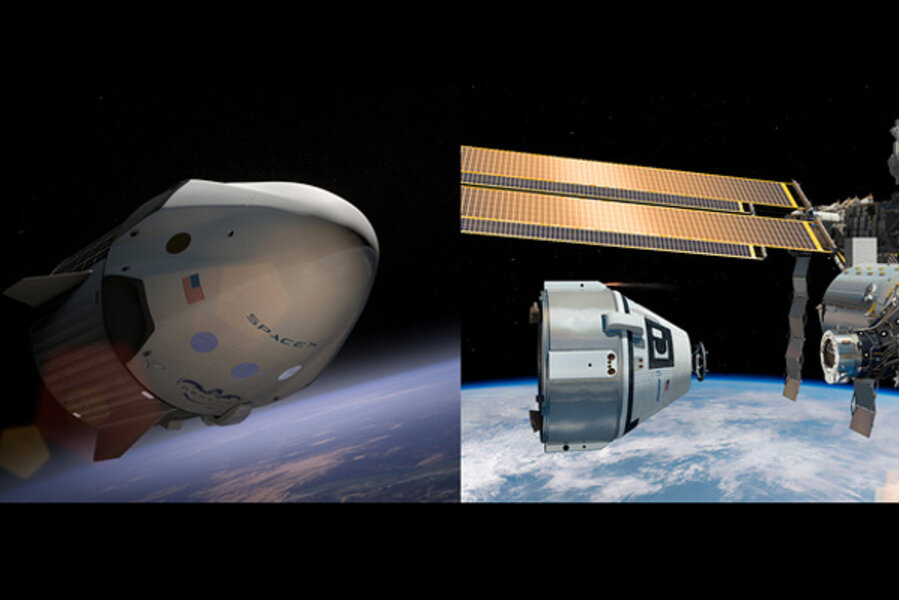NASA taps SpaceX and Boeing to ferry US astronauts into space
Loading...
American astronauts will soon have new homegrown rides into space.
After a four-year competition, NASA has tapped the commercial spaceflight companies SpaceX and Boeing to launch astronauts to the International Space Station from U.S. soil by 2017, agency officials announced today (Sept. 16). If all goes according to plan, the two companies will reduce or end NASA's dependence on Russia for its orbital taxi service. Russia's Soyuz has been NASA's only crew access to space since the space shuttle fleet retired in 2011.
"Today's announcement sets the stage for what promises to be the most ambitious and exciting chapter in the history of NASA and human spaceflight," NASA Administrator Charles Bolden told reporters today.
The choice reflects a melding of old and new; Boeing has been an aerospace mainstay for decades, while billionaire entrepreneur Elon Musk founded SpaceX just a dozen years ago, in 2002.
Filling the shuttle's shoes
SpaceX and Boeing are splitting NASA's $6.8 billion Commercial Crew Transportation Capability award, or CCtCap, the latest in a series of contracts set up in 2010 to encourage the development of private American manned spaceships. SpaceX will get $2.6 billion and Boeing will receive $4.2 billion, officials said.
NASA is looking to the private sector to fill the crew-carrying shoes of the space shuttle fleet, which was retired in 2011 after 30 years of orbital service. For the past three years, the agency has relied on Russian Soyuz capsules to fly its astronauts to and from space — recently, at a cost of more than $70 million per seat.
NASA officials have said they want at least one American commercial vehicle to be up and running by late 2017. A domestic capability to and from low-Earth orbit could not only cut costs but also free the agency to work on getting people to more distant and difficult destinations such as Mars, Bolden said.
Four companies have been major players in NASA's ongoing commercial crew competition: SpaceX, Boeing, Blue Origin and Sierra Nevada. SpaceX and Boeing are building capsules called Dragon and the CST-100, respectively. Blue Origin has been developing a conical craft called the Space Vehicle, while Sierra Nevada's entry was a space plane called Dream Chaser.
Like SpaceX, Blue Origin is led by a billionaire — in this case, Amazon.com founder Jeff Bezos.
Today's announcement apparently takes Blue Origin and Sierra Nevada out of the mix, but it doesn't eliminate competition from the commercial crew program. Under the CCtCap contracts, both Boeing and SpaceX will be required to go through a rigorous certification process, which will include at least one manned demonstration mission to the space station, NASA officials said.
"NASA is committed to ensuring these systems are held to the same rigorous safety standards as previous human spaceflight programs," said NASA commercial crew program manager Kathy Lueders.
After completing certification, Dragon and the CST-100 will each fly at least two, and perhaps as many as six, crewed NASA missions to and from the space station, Lueders added. Each of these crewed flights will carry four astronauts.
NASA will continue using both capsules as long as they meet the agency's requirements, Bolden said.
Meet Dragon and the CST-100
Both Dragon and the CST-100 are reusable vehicles designed to carry seven passengers. (CST-100's name, incidentally, derives from "Crew Space Transportation" and 100 kilometers, or 62 miles — the traditional altitude boundary that marks the beginning of outer space.)
Dragon is an upgraded, manned version of the robotic capsule SpaceX uses to fly cargo missions to the space station under a separate, $1.6 billion NASA contract. The crew capsule will ride to space aboard SpaceX's Falcon 9 rocket, as the cargo variant does.
The CST-100, meanwhile, will be lofted by United Launch Alliance's Atlas 5 rocket. The Atlas 5 currently uses a Russian RD-180 engine, but that may change soon; United Launch Alliance — a joint venture of Boeing and Lockheed-Martin — is reportedly tapping Blue Origin to build a new, homegrown engine for the rocket.
Both capsules will launch from NASA's Kennedy Space Center in Florida, officials said.
Follow Mike Wall on Twitter @michaeldwall and Google+. Follow us@Spacedotcom, Facebook or Google+. Originally published on Space.com.
- Commercial Human-Rated Spacecraft: Prototype Tests Continue | Video
- Quiz: How Well Do You Know SpaceX's Dragon Spaceship?
- Now Boarding: The Top 10 Private Spaceships
- SpaceX Crew Transport Vehicle Progresses To Manufacturing Phase | Video
Copyright 2014 SPACE.com, a TechMediaNetwork company. All rights reserved. This material may not be published, broadcast, rewritten or redistributed.





